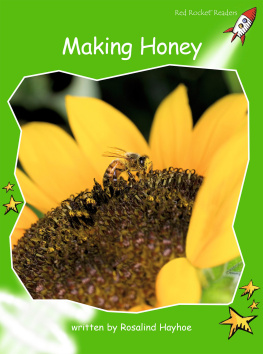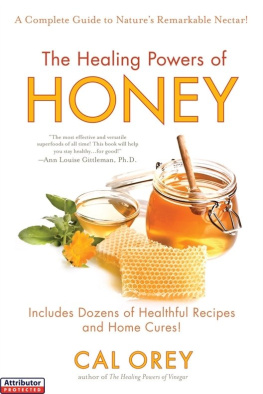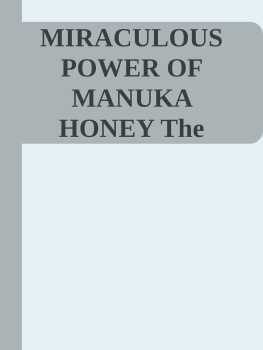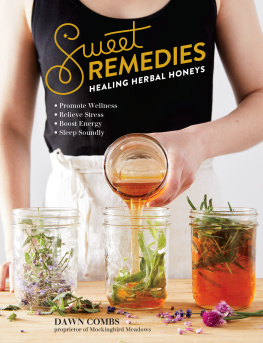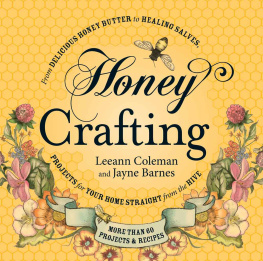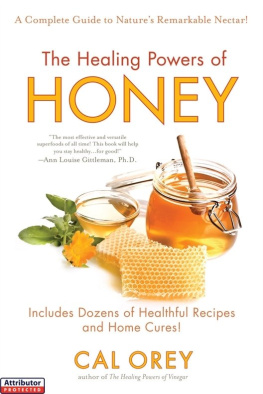Making Healing Remedies with Honey and Propolis
Carolyn K Gibson
DEDICATION
We thank God the Father for the bees and all the wonders of nature. We worship God the Father but not his creations.
Disclaimer
This book is for information only. It is not to be taken as medical advice. It is not meant to be a substitute for consulting with your healthcare provider.
Caution: If you are allergic to bees you could be allergic to honey or propolis. You could have an allergy to any of the herbs listed.
To err is human. Every attempt has been made to make sure all information is accurate. The author and publisher are not responsible for errors.
1. Introduction
The Lord has provided many natural remedies for us, herbs, honey and propolis.
As with all natural remedies they are difficult to verify in the test tube. Natural remedies are subject to the weather, where the plant was grown, or in the case of honey and propolis where the bees harvested these products, which particular property the bees were gathering for the benefit of the hive and what time of the year.
Longtime bee keepers here in the United States are just now discovering the healing properties of honey and propolis.
Europe and Asia have been using these bee products for centuries.
This book is not meant to provide all possible remedies or bore you with all possible research data.
This is meant to get you started and you should continue your own research. Nothing works like trial and error.
I have been making herbal remedies since the 70s and just started using honey and bee propolis in recent years.
My main research for honey and propolis include:
www.greenmedinfo.com
National Institute of Health
A part of the U.S. Department of Health and Human Services, NIH is the largest biomedical research agency in the world.
www.nih.gov
Propolis Power Plus by Carson Wade with Joan A. Friedrich, PH.D
Users Guide to Propolis, Royal Jelly, Honey, and Bee Pollen by C. Leigh Broadhurst, Ph.D.
The New Honey Revolution by Ron Fessenden, MD, MPH
The Honey Prescription by Nathaniel Altman: Medical Writer and Researcher
Two Million Blossoms by Kirsten S. Traynor, M.S.
Many herb books and classes
My personal experience
The NIH website has many recipes for making honey and propolis remedies. Some of their recipes contain ingredients you may not recognize and question if they are natural, petroleum jelly being the main one.
Other ingredients you may not recognize are:
Propylene Glycol: a natural gas
Sorbitol: from corn
Sodium Sterate: from coconut oil
Sodium Laureth Sulfate: from coconut oil
Glycerin: can be plant based or petroleum based, research your source
Titanium Dioxide: from ilmenite ore
All remedies do not work for all people. There are some remedies with propolis and some with honey or herbs. Which works for you may is a matter of personal experience and which that you have on hand. It is not like the Lord gave us only one remedy and if it is not available, tough luck. He put many different healing remedies all over the world. As you experiment, seeing is believing.
Natural remedies are not miracle cures that you can use one time and expect miraculous results. Just like the drug store medicines they need to be applied or taken several times a day.
Sometimes your immune system has been so compromised you will need to see a doctor and get a prescription.
Sometimes, nothing works.
Maybe you have been under a lot of stress, overworked or over obligated.
Your body will demand rest. If you getting sick are the only way to get rest, so be it.
Nutrition, exercise, cleanliness, rest and recreation may be the answer to the problem, and no amount of natural healing is going to take the place of these.
More research is showing our immune system begins in the gut. You may need to start taking probiotic.
This is not a religion. Natural remedies are a first step in healing; if it is not working see your medical professional.
2 Healing with Honey
The Lord made the bees and the flowers, and the bee makes the honey.
The bees gather nectar from the flowers; they bring it up back up from their stomachs, combine it with their spit to change the nectar into honey.
All honey is not equal in medical benefits. Lighter colored honey will generally taste better but does not offer the best medical benefits. The honey foraged from wildflowers would be more effective than a one crop honey. Honey foraged from conifer trees would be even more effective. The more variety of flowers the bee forages from the better the medical and nutritious benefits. The exception would be the Manuka honey and Revamil which has the most medical benefits.
Ancient cultures used honey therapeutically and many ancient texts prescribe honey for sores, wounds and sore eyes. It is valued all over the world as medicine except the United States. For some reason the United States does not value the research of other nations.
In the 1930s honey was scientifically proven to be an effective antimicrobial. In 1989 and 1992 there were many other studies providing proof of Honeys medical value.
Honey is so effective for skin wounds, that in the UK they have a medically approved honey that is used in the hospitals called Medihoney ( which is the Manuka honey) and in the Netherlands they have one called Revamil (which the bees are raised in a closed greenhouse to guarantee their source of nectar). Of course these honeys are very expensive. They are the only ones allowed in the hospitals. These honeys have been Gamma irradiation to kill all microbes and spores. The antibacterial potency of these honeys has been verified.
Manuka honey is rated by its antibacterial potency. UMF (Unique Manuka Factor). Medical professionals in New Zealand use Manuka honey for its medical benefits with a rating of at least 10 UMF. If you are paying the big bucks for Manuka honey check its UMF rating.
Go to the web site below for further information.
http://www.honey.bio.waikato.ac.nz
Regular raw, wildflower honey will work in most cases even though their antibacterial potency has not been verified. For serious infections you would definitely use the Manuka honey. Very serious infections will require the specially developed Manuka honey products such as gels and impregnated bandages.
Go to http://www.dermasciences.com for complete descriptions of these products. Order these products on Amazon.
Pathogens Treated with Honey: from 1992 Peter Molans review The antibacterial activity of honey
Bacillus anthracis:
Anthrax
Corynebacterium diphtheria:
Diphtheria
Escherichia coli:
Diarrhea, septicemia, urinary tract infections, wound infections
Haemophilus influenzae :
Ear infections, meningitis, respiratory infections, sinusitis
Listeria monocytogenes :
Meningitis
Mycobacterium tuberculosis:
Tuberculosis
Pasteurella multocida:
Infected animal bites
Proteus species :
Septicemia, urinary tract infections, wound infections
Pseudomonas aeruginosa:
Urinary tract infections, wound infections
Salmonella species:
Diarrhea
Salmonella cholerae-suis:
Septicemia
Salmonella typhi:
Typhoid
Salmonella typhimurium:
Wound infections
Serratia marcescens:
Septicemia, wound infections
Shigella species:
Dysentery
Staphylococcus aureus:
Abscesses, boils, carbuncles, impetigo, wound infections
Streptococcus faecalis:
Urinary tract infections
Streptococcus mutans:
Tooth decay
Streptococcus pneumonia:
Ear infections, meningitis, pneumonia, sinusitis
Next page

